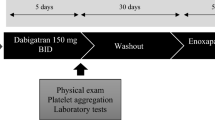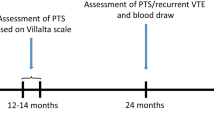Abstract
Several prospective studies have demonstrated that high plasma fibrinogen levels are associated with an increased risk of ischemic heart disease. Since in most patients an increased thrombin generation has been reported, we investigated whether the control of thrombin generation could affect plasma fibrinogen levels. Forty male outpatients (20 asymptomatic with previous myocardial infarction and 20 with stable effort angina) were enrolled in a randomized medium-term (6 months) cross-over study. Clottable fibrinogen, according to Clauss, prothrombin fragment 1+2, thrombin-antithrombin complex, and fibrinopeptide A were evaluated in relation to treatment with low-dose heparin. After a 15-day wash-out period, during which patients had been treated only with nitrates if needed, patients were allocated to two sequential periods of treatment with standard heparin (12,500 U, subcutaneously daily) plus antianginal treatment or antianginal treatment alone, separated by a second 15-day wash-out period. At the end of the treatment period with low-dose heparin significant decreases in the plasma fibrinogen (2.5±0.6 g/l vs. 3.3±0.5 g/l,P<0.001), prothrombin fragment 1+2 (1.4±0.5 nmol/l vs. 1.9±0.7 nmol/l,P<0.001), thrombinantithrombin (4.5±2.4 ng/ml vs. 9.7±3.6 ng/ml,P<0.001), and fibrinopeptide A (2.1±1.1 ng/ml vs. 3.5±2.1 ng/ml,P<0.001) were observed compared with the period without heparin. The present results indicate that low-dose heparin can effectively control the increased abnormal thrombin generation and elevated fibrinogen levels in patients with ischemic heart disease, possibly decreasing the risk of cardiovascular death.
Similar content being viewed by others
References
Ernst E, Resch KL. Fibrinogen as a cardiovascular risk factor: a metaanalysis and review of the literature. Ann Intern Med 1993; 118: 956.
Folsom AR, Wu KK, Rosamond WD, Sharrett AR, Chambless LE. Prospective study of hemostatic factors and incidence of coronary heart disease. The Atherosclerosis Risk in Communities (ARIC) Study. Circulation 1997; 96: 1102.
Thompson SG, Kienast J, Pyke SDM, Haverkate F, Loo JCW van de. Hemostatic factors and the risk of myocardial infarction or sudden death in patients with angina pectoris. N Engl J Med 1995; 332: 635.
Thompson SG, Fechtrup C, Squire E, Heyse U, Breithardt G, Loo JCW van de, Kienast J. Antithrombin III and fibrinogen as predictors of cardiac events in patients with angina pectoris. Arterioscler Thromb Vasc Biol 1996; 16: 357.
Hamsten A. Hemostatic function and coronary artery disease. N Engl J Med 1995; 332: 677.
Ross R. The pathogenesis of atherosclerosis: a perspective for the 1990s. Nature 1993; 362: 801.
Edwards RL, Rickles FR, Borbove AM. Mononuclear cell tissue factor: cell of origin and requirements for activation. Blood 1979; 54: 359.
Altieri DC, Edgington TS. The saturable high affinity association of factor X to ADP-stimulated monocytes defines a novel function of the Mac-1 receptor. J Biol Chem 1988; 263: 7007.
Altieri DC, Bader R, Mannucci PM, Edgington TS. Oligospecificity of the cellular adhesion receptor Mac-1 encompasses an inducible recognition specificity for fibrinogen. J Cell Biol 1988; 107: 1893.
Ceriello A, Pirisi M, Giacomello R, Stel G, Falleti E, Motz E, Lizzio S, Gonano F, Bartoli E. Fibrinogen plasma levels as a marker of thrombin activation: new insights on the role of fibrinogen as a cardiovascular risk factor. Thromb Haemost 1994; 71: 593.
Clauss A. Gerinnungsphysiologische Schnellmethode zur Bestimmung des Fibrinogens. Acta Haematol (Basel) 1957; 35: 565.
Pelzer H, Schwarz A, Stuber W. Determination of human prothrombin activation fragment F1+2 in plasma with an antibody against a synthetic peptide. Thromb Haemost 1991; 65: 153.
Pelzer H, Schwarz A, Heimburger N. Determination of human thrombin-antithrombin III complex in plasma with an enzymelinked immunosorbent assay. Thromb Haemost 1988; 59: 101.
Amiral J, Walenga JM, Fareed J. Development and performance of a competitive enzyme immunoassay for fibrinopeptide A. Semin Thromb Haemost 1984; 10: 228.
Neri Serneri GG, Abbate R, Prisco D, et al. Decreases in frequency of anginal episodes by control of thrombin generation with low-dose heparin: a controlled cross-over randomized study. Am Heart J 1988; 60: 115.
Mitropoulus KA, Esnouf MP. The prothrombin activation peptide regulated synthesis of the vitamin K-dependent proteins in the rabbit. Thromb Res 1990; 57: 541.
Franks JJ, Kirsch RE, Frith LOC, et al. Effect of fibrinogenolytic products D and E on fibrinogen and albumin synthesis in the rat. J Clin Invest 1981; 67: 575.
Low J, Biggs JC. Comparative heparin plasma levels after subcutaneous sodium and calcium heparin. Thromb Haemost 1978; 40: 397.
Gensini GF; Fortini A, Lombardi A, Pesciullesi E, Pieroni C, Neri Serneri GG. Binding of low molecular weight heparin to aortic endothelium on rabbits. Haemost 1984; 14: 466.
Neri Serneri GG, Fortini A, Gensini GF, Carini M, Pieroni C, Pesciullesi E. Heparin binding to human arterial endothelium. Thromb Haemost 1985; 54: 62.
Gensini GF, Bonechi F, Gori AM, Fortini A, Paniccia R, Lamberti R, Attanasio M, Martini F, Prisco D, Neri Serneri GG. Lowdose heparin as an antithrombotic agent. Haemostasis 1990; 20: 129.
Leung L, Saigo K, Grant D. Heparin binds to human monocytes and modulates their procoagulant activities and secretory phenotypes. Effect of histidine rich glycoprotein. Blood 1989; 73: 177.
Abbate R, Gori AM, Modesti PA, Attanasio M, Martini F, Colella A, Giusti B, Cecioni I, Neri Serneri GG. Heparin, monocytes and procoagulant activity. Haemostasis 1990; 20: 98.
Pepe G, Giusti B, Attanasio M, Gori AM, Comeglio P, Martini F, Gensini GF, Abbate R, Neri Serneri GG. Tissue factor and plasminogen activator inhibitor type 2 expression in human stimulated monocytes is inhibited by heparin. Semin Thromb Haemost 1997; 23: 135.
Neri Serneri GG, Abbate R, Gori AM, Attanasio M, Martini F, Giusti B, Dabizzi P, Poggesi L, Modesti PA, Trotta F, Rostagno C, Boddi M, Gensini GF. Transient intermittent lymphocyte activation is responsible for the instability of angina. Circulation 1992; 86: 790.
Holtslag JCWM, Moshage HJ, Pelt JF van, Kleusken JAGM, Grignau FWJ, Yap SH. Prostaglandin E2 and F2 alpha are not involved in the monocytic product interleukin-1 induced stimulation of hepatic fibrinogen synthesis in rat. Clin Sci (Colch) 1988; 74: 477.
Kishimoto T. The biology of interleukin-6. Blood 1989; 74: 1.
Hogasen AKM, Abrhamsen TG. Heparin suppresses lipopoly-saccharide-induced monocyte production of several cytokines, but simultaneously stimulates C3 production. Thromb Res 1995; 80: 179.
Attanasio M, Gori AM, Giusti B, Pepe G, Comeglio P, Brunelli T, Prisco D, Abbate R, Gensini GF, Neri Serneri GG. Cytokine gene expression in human stimulated monocyte is inhibited by heparin. Thromb Haemost 1997; (Suppl) 9.
Engelberg H. Low-dose intermittent heparin therapy decreases plasma fibrinogen levels. Semin Thromb Haemost 1991; 17: 219.
Neri Serneri GG, Rovelli F, Gensini GF, Pirelli S, Carnovali M, Fortini A. Effectiveness of low-dose heparin in prevention of myocardial reinfarction. Lancet 1987; I: 937.
Author information
Authors and Affiliations
Rights and permissions
About this article
Cite this article
Prisco, D., Paniccia, R., Bandinelli, B. et al. Effect of low-dose heparin on fibrinogen levels in patients with chronic ischemic heart disease. Int J Clin Lab Res 28, 170–173 (1998). https://doi.org/10.1007/s005990050038
Issue Date:
DOI: https://doi.org/10.1007/s005990050038




